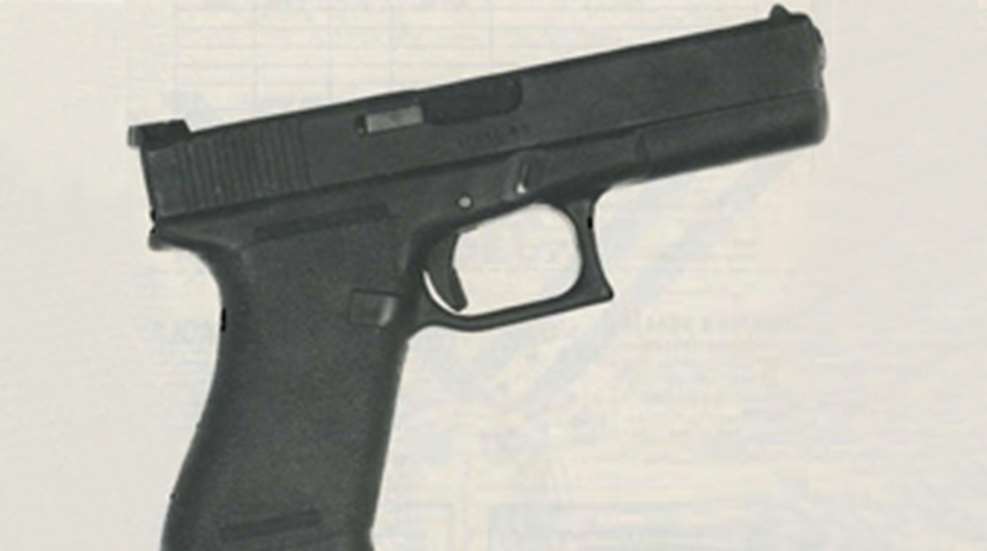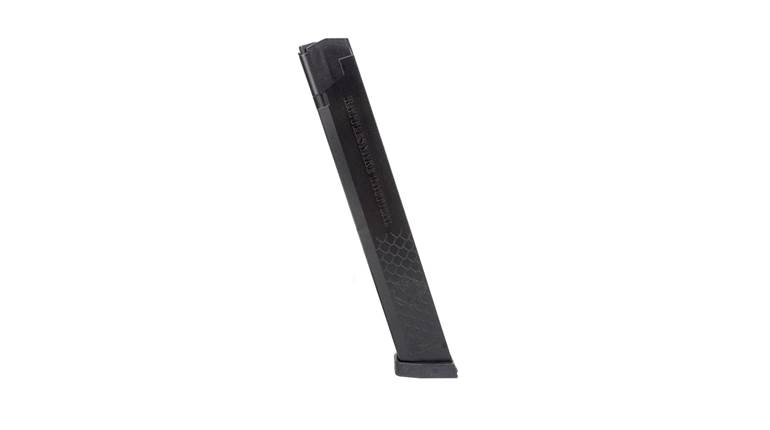
Originally published in the May 1986 issue of American Rifleman.
There has been a lot in the news media lately on the Glock 17 pistol. Most of it, as might be expected of the anti-gun press’s coverage of any firearms, is pure hogwash.
Without going into details that would lead to irritation at best and apoplexy at worst, it should be said that:
A: The Glock 17 is not an “all plastic gun”—it is, in fact and weight, about 83% steel.
B: The Glock 17 does not “pass through metal detectors undetected.” Nineteen ounces of steel plus about 4 ozs. of lead, if a pistol and a full magazine are considered, should trip any metal detector—providing the unit is plugged in.
C. The Glock 17 is not “invisible when passed through an X-ray screen.” It looks like what it is—again, provided the machine is plugged in, and assuming the viewer knows his or her business and is attending to it.
D. Given A, B and C, we are really baffled by this one: “The Libyans are said to be trying covert methods to obtain these weapons.” Why is the Glock 17 better for Libyans than other pistols? Since the Glock 17s are on the world market, why the “covert methods.” Last, but not least, who started the rumor and why—other than to make a catchy story? We don’t know and nobody in the U.S. or Austrian governments seems to either. Nor does Gaston Glock, the pistol’s designer, manufacturer, and chairman of the board at Glock G.m.b.H. of Deutch-Wagram, Austria.
Glock visited the NRA during the height of the anti-gun press idiocy on his pistol. Together with Wolfgang Riedl, his marketing manager, and Karl Walter, the U.S. importer, he could throw no light on the Libyan tall tale source or make anything of the press reports on his “detection-proof pistol.” So much for the rumors.
Glock, however, has many facts at his disposal, and we took advantage of his visit to get some first-hand information on what turns out to be a very interesting—but not supernatural—pistol.
His answer to our first question regarding his gun background was a real eye opener.
“In 1980, I didn’t know the difference between a pistol and a revolver” Glock told us. Things progressed from there.
In 1963, Glock, a mechanical engineer with a background in synthetic materials, formed a company to produce furniture and hardware. The company eventually made combat knives, bayonets, and entrenching shovels for the Austrian military that are still in the line and available in the U.S.
In 1980, Glock saw a copy of the Austrian military’s pistol requirement form, but thought little of it. Essentially, it called for 9 mm Parabellum chambering, a large capacity magazine, light weight and durability.
Then, however, his 15-man factory was approached by a foreign pistol maker that was interested in the Austrian requirement but wanted an Austrian manufacturing or assembly site—preferably Glock G.m.b.H. No deal was made, but Glock began to take matters seriously. When two more foreign pistol makers approached him with similar proposals, he made his decision.
He studied military pistols, test procedures and requirements from all over the world and, with two of his employees, turned out a working prototype in exactly six months. It didn’t suit him in every particular, so ,barely giving him time to return to the drawing board, he made a second prototype in two months.
That prototype is, in every detail, the same as the pistol now used by the Austrian Army and issued in a quantity of 28,000 pieces.
If there is a similar success story around that involves a man innocent of even basic gun knowledge, and a totally new gun, we are unaware of it.
At any rate, the deed was done and a major European nation is using the Glock. Is any other nation using it? Yes, Glock told us, Norway has accepted the Glock 17, and in three years the Norwegian Army will be totally armed with it. This is of more than passing interest for, while Austria is not, Norway is a NATO member and the Glock is, therefore, a NATO standard pistol. In addition, we were told, many military and police units are considering the Glock 17, and some have purchased it in more than trial quantities. Not the Libyans, however.
“Does the factory still only have 15 workers?”, we naively asked. Glock smiled and told us that, no, there are about 40 involved in the pistol project, but one man controls the computer panel that, in turn, controls all the ultra-modern, fully computerized machinery.
Here, Glock feels, is one of his great assets. He has visited many arms factories in the last few years and confesses to amazement at the great numbers of “obsolete equipment mixed in with some modern equipment” found in virtually all of them. Except his.
What use does Glock G.m.b.H. make of sub-suppliers, we asked, and again got a surprising answer and another reason that Glock thinks he has an advantage over the competition.
“We make absolutely everything ourselves except the springs and raw material. The steel slide material is received in profiled bar form; we mill it to shape. The polymer is received to our patented specifications; we mold it and so forth. We also do the finishing, of course, and use three hardening processes for the slide and barrel. The final hardening produces the patented 70 Rockwell Cone finish that is harder than a file.”
A two-part question was what Glock’s next firearm project would be and if he visualized an all-plastic gun.
To this, he said his next gun, if any, would be another one tailored to Austrian military requirements. He feels, and he should know, that plastics or polymers have not yet reached the stage where they could be used alone to produce a military-acceptable firearm.
As Glock was, with commendable speed, fully disassembling one of his pistols with only a small punch (a nail would have done nicely), we gave him a final question.
“How does the U.S.-imported Glock differ from your Austrian and Norwegian service pistols?”
We were told that the only differences, aside from markings, are that to the U.S. pistol was added the molded-in serial number plate in the polymer frame, and the rear sight that is click-adjustable for elevation. Period.
Other questions remained, but these were best answered, in the absence of Messrs. Flock, Riedl and Walter, by a normal examination of and test session with the intriguing new pistol.
The Glock 17 is a locked-breech, hammerless pistol that is sometimes called a “double-action.” The term is misleading, and while Glock’s preferred term “Safe-Action” is not self-explanatory, Glock’s terminology and parts illustration are used here to explain matters.
When the slide (1) is retracted and released, the firing pin (5) is partially held back (“half cocked”) by the cruciform sear plate on the rear of the trigger bar. This does several things: it keeps the firing pin from primer contact; it allows the passive firing pin safety plunger (9) to block pin movement; and it shortens the necessary final movement or cocking of the firing pin by trigger depression when discharge is wanted.
The pistol always works that way whether the slide is retracted manually to load the chamber or the first shot or by recoil for subsequent shots. Thus, there is no difference in the trigger pulls for the first shot vs. subsequent shots. Such different pulls are necessary with conventional double-actions that really operation as “long-pull” double actions for only the first shot and “short-pull,” self-cocking single-actions thereafter.
The sample Glock 17 that we tested had a smooth, constant, medium-length pull of about 6 lbs., but lighter or heavier pulls can be had by substituting the appropriate trigger springs that are available from the importer.
The trigger itself contains the pistol’s only manual “safety.” This is a pivoted lever that protrudes through the face of the trigger and extends through the trigger’s body to emerge again at its top rear where it contacts the frame. When the trigger is depressed by the shooter in normal fashion, the safety lever pivots and its rear portion moves up into the trigger body and out of contact with the frame. The trigger is then free to move backward and effect discharge.
The depression of the safety lever requires no effort as its return spring is very weak. The Safe-Action name is derived from it, and the main advantages of the system are simplicity and insurance against firing if the loaded pistol is accidentally dropped. If, as in a combat situation, the decision is made to carry the Glock with the chamber loaded, the soldier need not question whether a conventional thumb safety is “on” or “off.” The pistol will fire when the trigger is pulled, for the safety lever will automatically be pivoted out of engagement with the frame.
Obviously, this is unusual, and Glock’s manual stresses the point that the pistol should be carried “empty, with the trigger rearward except when you intend to shoot.” It is impossible to carry or set the pistol so that the trigger remains back when a round is chambered.
The trigger’s safety lever, then, can be said to prevent the trigger from being depressed until purposely depressed by the trigger finger. Its presence and the absence of any other manual safety require that particular attention be paid to familiarization with the Glock 17 by a prospective user, particularly one used to a more conventional pistol.
Aside from the trigger, trigger safety, and “half-cock” firing pin systems, the mechanics of the Glock 17 are fairly straight forward.
Takedown is accomplished by first pressing the magazine catch (19) located on the left of the frame behind the trigger; the magazine will drop of its own weight from the beveled magazine well.
The slide is then opened and closed to make sure the chamber is empty. Then the trigger is pulled and will remain in its rearward position; the slide is opened a quarter inch or so, and the locking slide (21) above the trigger is pulled down.
With the locking slide depressed, the slide unit is slid off the front of the frame. Now the recoil spring and tube (3 & 4) can be removed, followed by the SIG-type barrel (2) with its squared chamber area that forms the massive locking lug. The barrel’s underside has an open cam (also reminiscent of SIG) that engages the steel locking block (22) molded into the polymer receiver.
That completes the field-stripping of the Glock 17 and further disassembly, though possible with only a nail, is not recommended by the factory.
The polymer receiver, when stripped of the slide unit, reveals the working trigger/sear parts, the locking block and the slide stop lever (27). All are of steel, as are the four molded-in slide “rails” that measure about .4” in length and are located in pairs at the rear of the receiver and above and forward of the two-hand hold trigger guard.
The broad, flat-topped front sight is .17” wide with a white dot insert; the flat-topped rear sight, with an inserted white bracket, has a .125”-wide square notch, and the resultant 7”-radius sight picture is excellent. Nevertheless, some doubts were voiced by shooters prior to accuracy and function testing.
What was expected was a certain military crudity in handling qualities and heavy recoil from the polymer-framed pistol’s light weight. What was discovered was that the Glock is in fact an unusually pleasant pistol to fire.
The Glock’s firing pin is worthy of mention, as it is rectangular in cross section, with a convex nose. The fired primer takes on the raised rectangular impression of the slot-like firing pin hole in the breech, with a firing pin indent in the center. It looks odd but, we found, works well.
The 17-round steel-lined magazine is loaded with the aid of a plastic loading tool packed with the gun. It is a sleeve that telescopes the magazine. A wedge inside its top presses downward on the magazine follower, allowing easier insertion of ammunition, but once it is mastered, a magazine can be loaded in short order, with no sore fingers.
Firers anticipated that the Glock’s trigger arrangement, requiring half-cocking for every shot, would result in a springy, hard-to-manage pull. This was not the case. While it is hardly a competition trigger, the Glock’s 6-lb. pull is an easy one to master, and has the advantage over conventional double-actions of a consistent pull on all shots.
The pistol’s pointing qualities make it hard to believe that its designer is a man of limited firearms experience. The grip is very well designed, both from the standpoint of recoil absorption and instinctive pointing. Both ham-fisted and diminutive firers found the trigger and slide release easy to reach. Rapid-fire, either one- or two-handed, was facilitated by the pistol’s limited muzzle jump. In short, the Glock 17 handles quite as well as any large-capacity 9 mm tested in recent memory.
Over 300 rounds of mixed ammunition have been fired from our sample Glock 17. There were no malfunctions of any kind, and representative accuracy figures are shown in the accompanying table. That sounds good and it is, but according to Glock, the Austrian military has repeatedly fired five-hour test sessions of 10,000 rounds each “successfully,” that is to say, without a single misfire or malfunction.
Austrian soldiers are, apparently, a quick-shooting, hardy lot, and the Glock 17 should suit them well.





































